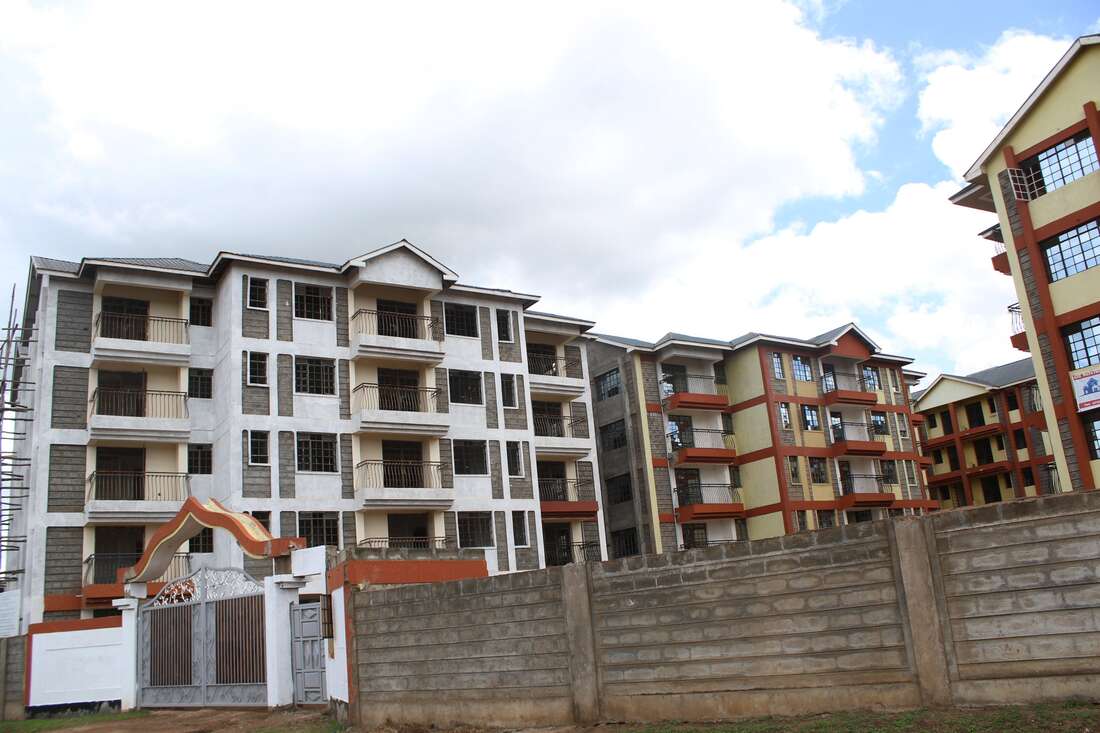[ad_1]
Market News
Home prices drop as land value increases
Tuesday May 11 2021
Apartments in Makongeni, Thika. PHOTO | KANYIRI WAHITO | NMG
Summary
- Investors who froze investments in land at the peak of the Covid-19 economic crisis are slowly returning to the market on the improved business environment.
- The sluggish price movement has hit property developers and land speculators while offering a bargain to real estate investors.
Land prices in Nairobi and the surrounding counties of Kiambu, Kajiado and Machakos have increased in the three months to March on the back of ongoing recovery from coronavirus hardships that failed to lift home prices.
HassConsult, which conducts a quarterly property pricing index in Kenya, said on Monday that land prices increased 0.2 percent in quarter one — the fastest growth since the country reported the first Covid-19 case in March last year.
Investors who froze investments in land at the peak of the Covid-19 economic crisis are slowly returning to the market on the improved business environment.
But home prices remain subdued, recording a minimal drop of 0.07 percent in the period to March compared to a cut of 1.2 percent in the quarter ended December.
HassConsult has linked the price fall to an oversupply of homes amid reduced demand related to the Covid-19 economic fallout, which has led to job losses, pay cuts, closure of firms and cuts on bank loans and mortgages.
The price movements may look minimal, but the impact is reflected in the fact that land and home prices have recorded double-digit annual increases in recent years on increased demand for real estate.
The sluggish price movement has hit property developers and land speculators while offering a bargain to real estate investors.
Land prices rose fastest in surrounding satellite towns driven by Kenya’s growing middle class that cannot afford property in the capital.
“Overall land prices in the suburbs posted a modest 0.2 percent increase over the quarter while the satellite towns saw a
1.5 percent rise,” said Sakina Hassanali, head of property development consulting and research at HassConsult.
“While there is flattening of demand, this does not mean that demand is going to be low for long,” added Ms Hassanali.
HassConsult data shows that prices of land in areas such as AthiRiver, Juja, Mlolongo, Limuru and Ngong increased by between 0.8 percent and 6.07 percent.
The price of an acre in Ngong increased by the largest margin of 6.07 percent to Sh25 million in March from Sh23.7 million in December.
It rose 4.2 percent in Mlolongo to Sh29.8 million and 3.28 percent in Tigoni to Sh25.2 million.
The land prices boom in satellite towns has been driven by the appetite for home ownership by Kenya’s growing middle class.
The high appetite for property saw coffee plantations in Kiambu cleared to pave the way for gated housing estates and shopping centres.
An acre in Kiambu dropped 2.07 percent to Sh37.8 million while Kitengela recorded a 1.59 percent drop to Sh12.4 million.
Land prices in Nyari, Lang’ata and Gigiri rose by the biggest margin of 2.18 percent, 1.26 percent and 1.18 percent respectively in Nairobi.
An acre in Nyari rose to Sh107.9 million and Sh232 million in Gigiri, where the UN complex sits.
Donholm also recorded a price increase, with an acre rising 2.76 percent to Sh70.8 million.
But Riverside and Parklands defied the trend, with price drops of 1.69 percent to Sh338.1 million and 0.92 percent fall to Sh375 million respectively.
Upper Hill is listed as the costliest location, with an acre going for Sh511.2 million followed by Westlands at Sh421.7 million and Kilimani Sh415 million.
Housing has been one of Kenya’s fastest growing sectors over the past decade, fuelled by a growing middle class, with returns from real estate outpacing equities and government securities.
This fuelled a boom in land whose prices have increased nearly four-fold in Nairobi and surrounding satellite towns like Kiambu, Ongata Rongai and Kitengela.
The feverish rise in house and land prices has led to a bubble, setting the stage for multi-billion shilling loan defaults from property developers who had placed their bets on Kenya’s real estate.
Home prices in high-end estates shrugged off the bearish market to record marginal gains while houses in estates targeted by the middle class like Donholm and suburbs of Juja, Rongai and Kitengela recorded drops. Donholm, Juja, and Rongai homes fell 0.6 percent, 4.2 per cent and 1.5 percent respectively.
On average, the cost of homes in Muthaiga rose 2.6 percent, Loresho (2.8 percent) and 2.4 percent in Kileleshwa.
[ad_2]
Source link
















